Mariella Hunt's Blog, page 36
June 22, 2016
Book Review: Between the Lines by Jodi Picoult & Samantha Van Leer
What if there was a character who wanted to escape the pages of his book? How far would he go to live among readers?
Between the Lines tells the story of Prince Oliver, who wants to do just that. He’s lived in a book for as long as he can remember, and doesn’t see magic in it anymore. He wants something new and exciting, because his life has been programmed to always follow the words of the book.
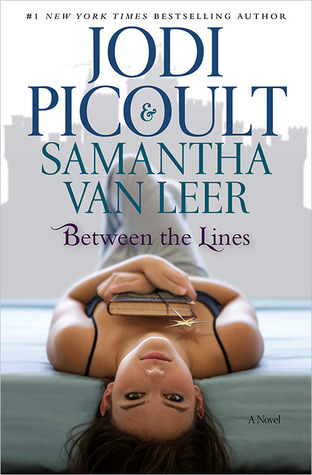
Oliver has several reasons for his restlessness, including:
Boredom—he is tired of finding himself on Page 1 each time a Reader opens the book.
He does not care for the love interest, Seraphima, but has to pretend in scenes where they kiss.
It irritates him, seeing how content his friends have become. They don’t wonder about the outside world.
But he never actually thought it possible to leave the book. It seemed pointless to even try. Then a new Reader becomes hooked on Oliver’s story.
When Delilah finds the book in her school library, the story becomes a refuge from the complications in her life. Oliver falls for Delilah so deeply, he gets her to notice him! Then he begs for help escaping the book, and they start experimenting.
Is it possible to change a story once it’s put in ink? Can a character’s will be strong enough to outsmart the book?
This is a charming story because of the questions it makes you ask. How many times have you wished a character could hang out with you? How many times have you wanted to live among the pages with them?
Between the Lines captures the wonder of good story, the pull which keeps us turning pages.
It may be impossible for characters to leap off the page, but this story gives us a comforting thought: If they had the choice to join us, some would without thinking it twice. Some would fight to live with us, just as we long to be near them.
Between the Lines pulls us into a realm where ink isn’t a barrier. In this realm, there is hope that one day readers and characters could meet.
I recommend this book to fans of faery tales and romance—but really, it’s great for any reader who’s fallen in love with fictional characters. Oliver’s story will give you much to think about, and it will make you smile.
Filed under: Book Reviews Tagged: book review, faery tale, jodi picoult, reading, romance, YA Literature








June 20, 2016
4 Reasons Why You Should Write Steampunk

Before I get into my reasons for why you should try writing a story set in a steampunk world, I should probably explain what steampunk is. Honestly, there is no set definition for steampunk, but it tends to be a story set in a world reminiscent of the past but with anachronistically advanced technology, attitudes, fashion, or all of the above. Think of the movie Wild Wild West or The League of Extraordinary Gentlemen. Many of these stories are set in an alternate version of the late-eighteen hundreds, but some are in a neo-Victorian future or something completely different that still hints at steampunk’s Victorian origins. The genre is open and growing and waiting for more authors to explore it.
Still unsure? Well, here are a few why you should write a steampunk story:
Half of your world-building is already done. Even if your world is mostly from your imagination with monsters, mechanical spaceships, or robot servants in Downton Abbey, you still have the scaffolding of real history. With a little research, you can establish chunks of your world-building, such as manners and customs, social hierarchies, fashion, architecture. It doesn’t matter if you set your story in England or India, historians during the Victorian era wrote volumes and took photographs! You have tons of inspiration right at your fingertips.
You can rewrite history. Since steampunk is an alternate history, you can change a historical event and completely rewrite history from that point on. Have you ever wondered what would have happened if women got the vote while Jane Austen was alive? Or what if Napoleon had succeeded in conquering and uniting Europe? Steampunk is a genre that is all about manipulating history and exploring the what-ifs. Have fun with it. See what can happen with just a little change.
You can utilize historical figures. Are there any historical figures that you find absolutely bad-ass, twisted, or just plain interesting? If you set your steampunk story during the same time period as your favorite historical figure, they can make a cameo or they can be one of your stars. Think of Hamilton. History with a twist. What if Tesla had even more advanced technology or what if he and Edison got into an escalating battle that threatened the world? You could even go as far back as Cleopatra’s time. Could she have defeated Caesar if she discovered some cutting edge technology in the Library of Alexandria? Do your research, explore your imagination.
You can create wild, new devices or machines. Let your imagination run wild. If you have an interest in science or engineering, steampunk is the perfect place to crack your knuckles and get writing about whatever strange device has been bopping around your brain. Your new tech can destroy planets, cure diseases, or just chug, pop, and belch steam. Steampunk often relies on the mixing of old and new technology to change history, so think about what Cleopatra could do with a laser or if the Vikings could have conquered the world with flying ships powered by steam.
Steampunk is one of the most open genres in literature, and with boundless possibilities, it’s yours to explore and make your own. Write a short story, write a novel, draw a futuristic cityscape, or even a play. Give it a try.
 Kara Jorgensen is an author of fiction and professional student from New Jersey who will probably die slumped over a Victorian novel. An anachronistic oddball from birth, she has always had an obsession with the Victorian era, especially the 1890s. Midway through a dissection in a college anatomy class, Kara realized her true passion was writing and decided to marry her love of literature and science through science fiction or, more specifically, steampunk. She has an MFA in Creative and Professional Writing and hopes to one day live off her writing. You can find her first book here.
Kara Jorgensen is an author of fiction and professional student from New Jersey who will probably die slumped over a Victorian novel. An anachronistic oddball from birth, she has always had an obsession with the Victorian era, especially the 1890s. Midway through a dissection in a college anatomy class, Kara realized her true passion was writing and decided to marry her love of literature and science through science fiction or, more specifically, steampunk. She has an MFA in Creative and Professional Writing and hopes to one day live off her writing. You can find her first book here.

Filed under: Guests, Writing Tagged: guest post, kara jorgensen, steampunk, writing, writing tips








June 16, 2016
5 Acceptable Ways to Procrastinate Editing

Experienced writers know their work isn’t through after the first draft. The opposite is true: Your first draft is the beginning of a long, tedious cycle. Quality work comes from months of writing, editing, and rewriting.
Most of a writer’s stress emerges in the editing phase. If done without pause, editing can make you sick. I’ve spent hours staring at sentences, trying make them perfect. Sometimes this is a sign you’re done editing—Briana Morgan discusses this in her article, When to Stop Editing. In my case, I rarely feel my work is good enough. When I reach the obsessive phase, I know I have to stop.
Not only are breaks healthy for authors, they improve writing quality. Stepping away from the manuscript lets us spot errors more clearly.
If you’re worried about losing your storytelling spark during this break, never fear. Writers find inspiration in everything we do; here are five guilt-free ways to pass time spent away from your manuscript.
GO OUTSIDE.
Many writers forget to go breathe fresh air (I’m one of them.)
A manuscript is so demanding! It eats our time, and we lose track of days…months…seasons…
Go outside to read in the backyard, or photograph flowers as they bloom. Take a walk and pay attention to people on the streets. If you meet someone walking a cute dog, ask if you can pet the dog—fluffy animals always make things better!
Gather life experiences to write in your next story.
READ A LOT.
For a writer, reading is crucial. Each time we read a published work, we open the door for improvement in the craft. If you’re mentally worn out from edits, reading is perhaps the most beneficial way to keep busy.
We learn to write well by exposing ourselves to good writing. Reading shows us:
Character traits, and how to write realistic protagonists.
Punctuation and grammar. You may have gotten good grades at school, but it never hurts to brush up on this by seeing it used first-hand.
Description. Let an experienced author sweep you away with words; learn their secrets to improve your prose.
Story structure. Pay attention to a book’s story arc, and try to identify the midpoint and climax. Writers need to know this.
She’s Novel offers insight on this in her article, How to Read Critically and Become a Better Author.
UPDATE YOUR BLOG.
As someone devoted to writing and blogging, I struggle to manage both projects once in the heavy editing mindset.
It affects my blog. When I get caught up editing, I forget to plan posts ahead of time, resulting in weeks of no updates.
It affects my writing. In the back of my mind, I know pageviews are probably going down; I know I’m ignoring my blogging schedule, which creates a whirlwind of guilt and conflict.
This is your chance to make up for the time you spent neglecting your blog.
CLEAN YOUR WORKSPACE.
Of the five options, this doesn’t sound like the most exciting way to kill time. Trust me, it’s necessary.
During the weeks spent immersed in edits, I bet you didn’t empty your wastepaper basket. A pile of books has accumulated on your desk, your carpet may need vacuuming, and shoes have ended up all over the place.
It’s ridiculous how fast a workspace can get messy. You might ask yourself, “How did that coffee cup end up here?” Or, “Where did that layer of dust come from?”
Tidying up will make you feel better about returning to edits.
TAKE LOTS OF NAPS.
Catch up on rest you’ve neglected while working.
Many people don’t realize the effort edits require; it can be physically draining. Don’t feel ashamed to sleep for a while. Just because you’re not actively working on something, doesn’t mean you’re not making progress.
Your body and mind need recharging in order to do a good job.
It’s tempting to open that manuscript and make one more, tiny change. Trust me, you’ll make more progress after letting it go for a while.
Two weeks may seem like a long time to not get editing done, but don’t worry. You will finish, and the resting period will help you produce quality work. Remember, time flies—before you know it, you’ll be at the computer editing that manuscript…again.
You may even find yourself wishing for another break. How’s that for irony?
Filed under: Writing Tagged: editing, reading, writing, writing tips








June 14, 2016
Book Review: The Bookseller by Cynthia Swanson
The Bookseller follows a woman named Kitty who lives in Denver, where she runs a bookstore with her best friend, Frieda. In 1962 it’s not usual for her to be unmarried at the age of thirty-eight, but she tells herself she’s content. Having gone through a failed courtship and several dates that led nowhere, she’s come to terms with life at home with her cat.
Things aren’t as stable as she’d like them to be. The bookstore is losing business as customers flock to big shopping centers in town. She and Frieda are struggling to pay the rent, contemplating the idea of moving to a location that’ll attract more business.
In the midst of this uncertainty, Kitty begins to have strange dreams. Each night when she drifts off, she finds herself in an alternate universe where everything is different.
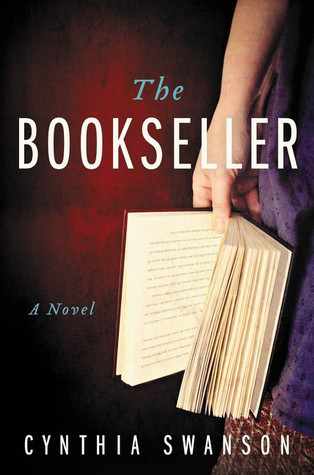
Kitty’s married with children in this universe. Her husband, Lars, is a man she spoke to once in the waking world, on the phone; they never met, but in the dream they are married. They have started a family; he built a lovely house for her and the children.
In this dream universe, Kitty is wealthy and has plenty of friends. She has a closet of elegant clothing, even a maid. The world she visits in her sleep is full of contradictions to her real life; it’s like the flip side of a coin.
As the dreams become more vivid, readers are left wondering which of the two universes is actually a dream? It becomes hard to decide. Cynthia Swanson has done a good job of taking two outcomes and making both of them plausible.
The Bookseller addresses the timeless question “What if?” We’ve all wondered how our lives could be different if we made that choice differently, or took the left road instead of the right. How would the universe change if we embraced a different hobby? How would it change the future, how would it change us?
This novel drew me in with its poignant writing and powerful scenes, making me question my own life. As the story progressed and fog cleared, I marveled at Swanson’s genius: She took a concept difficult to pull off, writing each reality with grace and elegance. Both of them have their pros and cons. Neither is complete.
But life is never truly complete. This truth doesn’t escape the pages of books. The Bookseller is wonderful because it makes us ponder our own choices, compelling us to ask “What if?” the way we did when we were children.
Life might look better in an alternate universe, but we’d find ourselves missing things we don’t notice now. The Bookseller helps us appreciate what we have, not envying others’ lives or wishing away our truths.
Like Kitty does in both realities, we’ll wake up and realize these little things are gone. But they only seemed little when we took them for granted, because they will leave great voids.
The Bookseller is a beautiful piece of literary fiction, one I can rate five stars without thinking twice. Give it a try and let it change your perspective on life.
Filed under: Book Reviews Tagged: book review, books, cynthia swanson, literary fiction, literature, the bookseller








June 13, 2016
Movie Review: Begin Again
Stories can lose their soul if edited too much. This is true regardless of the medium used—books, movies, music. It’s a struggle not to polish a piece so thoroughly that it loses its humanity, a truth told in the film Begin Again.
Dan used to be a successful music label executive, but he hasn’t adapted to changes in the industry. It’s not that he has nothing to choose from—demos are mailed to him every day. He just doesn’t want to pick up a bad record saturated in auto-tune.
The determination to live by his standards, not bowing to what’s popular, has gotten him in trouble. He hasn’t signed an artist in years. It’s having disastrous effects on his career, even changing the way his family sees him.
When the record company fires him, it kills what remained of his confidence. That night he finds himself at a bar, drinking away his misfortune. In this moment of crippling hopelessness, he overhears an acoustic performance that’ll change everything.
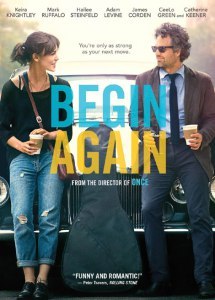
Gretta (Keira Knightley!!) is a songwriter recovering from a difficult breakup. Prompted by a friend, she’s reluctantly gone onstage to play her latest creation. No one seems to be listening but Dan, who approaches her and asks if she would consider working with him.
He could get his job back. She could land a record deal. What really happens is healing: Dan and Gretta are both lost souls, but help each other back up.
The songs alone are interesting, because they’re recorded on the streets of New York where life can be heard—this includes traffic, people, angry pedestrians. It created a sensation of music roaming the sidewalks, filling people with life.
Though Gretta’s songs are powerful, I had to check online to make sure Keira Knightley was singing. It was just bizarre to see her behind a microphone. People have criticized her voice, but I thought it lovely, the lyrics human enough to draw me in.
Begin Again teaches that art shouldn’t look or sound the same. It reminds us not to give up on our passions. Human feelings will capture hearts, time and time again. And we should not compromise who we are if it leads to unhappy success.
If we’re passionate about something, we ought to be careful. Some paths promise happiness, but will only make us drag our feet.
This story celebrating honest art made me contemplate my motives. Do I write because I love it, or for the sake of an audience? Would I compromise my story’s soul for the sake of a larger number? Am I going to follow trends I don’t like, just to make a name for myself?
These are questions all storytellers should ask. It’s tempting to follow crowded paths to success, but remember—we might forget the sound of our own voices, trying to mimic others.
Filed under: Movie Reviews Tagged: art, indie film, keira knightley, movie, movie review, music, storytelling








June 10, 2016
3 Ways to Heal Through Storytelling

The storytelling process is often described as healing; it lets us explore situations on a deeper level. There’s nothing like uncovering heartbreak, letting wounds heal in fresh air; however, it takes courage to bare your soul in a way that’s often public and raw.
Even truths told in allegory can be difficult for the person saying them. Readers see an eloquent passage, but the storyteller knows what it means. Many are afraid to express themselves through writing, because it’s often too powerful.
Sometimes it isn’t done on purpose. After publishing Dissonance, I looked at scenes I’d written and marveled at how personal they felt. I’m not dealing with the same situation as Allie, but truth slipped through the cracks about my greatest struggle at the time I was writing it.
I would elaborate on this, but it would spoil Dissonance and I want you to read it! To keep it short, storytelling heals—it’s not just a cliché. If true, the words come from your soul; you never know what’ll come to the surface of your manuscript.
You might be nervous about writing for this reason alone, and it’s understandable. Here are three tips for people who want to use storytelling to heal. I hope you try, because the struggle is worth it.
KEEP A FICTION JOURNAL.
If you’re struggling with the past, someone might already have told you to write in a journal—so I’m going to take it a step further. Keep a journal where you write fiction. There is truth in fiction, though many scoff at it for being fake.
The fact is, you might find more truth in fiction than traditional diary entries. Fiction allows us to push boundaries, expressing truths the way our hearts see them. With fiction, we have no limitations at all.
BE PATIENT WITH YOURSELF.
Don’t force a story if you aren’t feeling it—that just adds to the stress. Unless you’re on a deadline, there’s no hurry to get the chapter polished. This story is meant to help you heal, and no one may ever read it but yourself. You’re doing it for you.
Besides, writing is rarely good when forced. Set small goals, and don’t beat yourself up if you can’t reach them. What matters is that you make the effort, because over time you’ll craft a story, and the effort will pay off!
AVOID SETTING LIMITATIONS.
In a first draft, you’re allowed to break the rules. Play with genres to find one that lets you express yourself best. It’s also fine to have fun and combine several. The point is to get your message on paper so you can see the big picture.
What we want is to understand ourselves; no one is the same, so our work can take any shape or size. Since you don’t have to publish this piece, allow it to be different—even if only you understand it!
The most powerful stories are based on real emotion. A lot of people think telling the truth means crossing a line that shouldn’t be touched; in reality, there might be readers experiencing struggles similar to yours. Over time, you might write the story they relate to best, helping them cope in a personal way.
Remember, though: This writing should exist to help you, the storyteller. Don’t rush it for the sake of fame. Your masterpiece will come when it’s ready; it’ll be worth the grueling, often painful process of putting words on paper.
Let’s fill the world with writings of truth; nothing is more original than the story you’re living now.
Filed under: Writing Tagged: Dissonance, storytelling, writing, writing tips








June 7, 2016
Book Review: Unrivaled by Alyson Noel
Success can be a vicious game. Unrivaled by Alyson Noel follows three young people participating in a competition to best promote the hottest new clubs in downtown LA. They all hope to win best promoter and use their victories to pursue other ambitions.
None of them could foresee how fiery the race would become.
Aster, Tommy, and Layla are not the only competitors, but they’re clearly putting the most effort. This whole book follows their often desperate attempts to sit well with the boss, Ira Redman. Ira owns the nightclubs, and he’s going to determine who wins this competition…but since it’s unclear what his standards are, the participants pull strategies of near Hunger Games-level riskiness.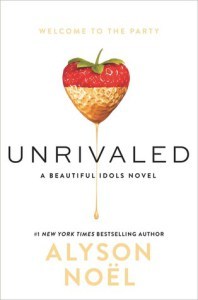
Luring celebrities in is an obvious shortcut; by the midpoint, they’re circling like flies around Madison Brooks, impeccable actress and America’s sweetheart. (I kept thinking Taylor Swift.) Since Madison is almost impossible to come by, their second-best choice is her also-famous boyfriend, Ryan Hawthorne. Through him, they each hope to reach her.
But the quest for Madison’s attention soon becomes a dramatic search—because she disappears. Aster, Tommy, and Layla all wind up as suspects.
This all started because they wanted success, money to make their marks in the world.
LA was a town of actors and storytellers, populated by those more comfortable playing an imaginary role than being themselves, and the prize always went to the one who faked it best.
This is not a genre I typically read. I was sent a copy to review, and found myself hooked by writing that pulled me along with the characters. Some of the quotes were truly beautiful, others intense—there’s enough cussing to make scenes properly intense. All the characters, even Madison and Ryan, were sketched perfectly; they felt like real people.
Having been in LA, it was nice to read descriptions of streets; I pictured myself strolling the Walk of Fame, could almost smell big city air. It was like stepping through a window back into California, a place where you never know what you’ll find around the corner.
The character Aster is my only criticism. Most of her choices were too childish, like she was trying to fit into a grown woman’s shoes. Then again, this is an LA version of the Hunger Games; I can forgive her losing sight of reason in the race to beat Layla, who ironically becomes an ally towards the end.
More than the characters, it’s the situation which I found addictive, like a bad tabloid or a reality show you can’t turn off…except this is well-written, a journey into the dark part of fame. By the end of Unrivaled, you’ll ask yourself what you’d do for success—and if it’s worth the losses.
You might even lose yourself in the process.
Filed under: Book Reviews Tagged: alyson noel, book review, contemporary, reading, YA Literature








June 5, 2016
Movie Review: Walt Before Mickey
Storytellers learn so much researching those who came before us. From them, we learn there’s never an easy path to getting an audience; tears will be shed, friends lost, and there’ll be moments in which we’re tempted to give up.
I have a book about Walt Disney in my towering TBR pile; it will no doubt be a wonderful read, when I get around to it. I’ve already been inspired by his story because of the movie Walt Before Mickey. Stories are told in film as well as books; storytellers ought to pay attention to both.
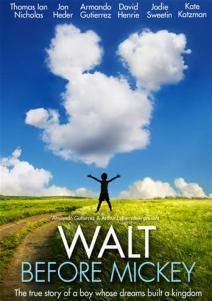
Walt Before Mickey follows Disney’s life before the creation of Mickey Mouse. It’s a movie that shows there’s genius in failure; it doesn’t only bask in the cartoonist’s success. There were powerful scenes showing Disney penniless and alone on the streets.
In those scenes, it’s difficult to imagine him fulfilling his dream.
This movie also shows moments of grand determination. Disney has a dream, and he’s going to work himself to the bone until it comes true. He won’t buckle under pressure from his family. He keeps going, showing willpower I can only hope to have one day.
It’s inspiring because it shows that hard work pays off. Not only that, Walt Before Mickey celebrates things he did achieve before his greatest success. It shows that, even if we’re not where we want to be yet, the journey can be lovely.
The setting was beautiful, costume and dialog making me want to travel by train or write on a typewriter. I could almost smell the cigarette smoke; these scenes evoked a sense of being in the story.
Chasing a dream is never easy, and it’s often tempting to give up when we’re almost there! Walt Disney’s story shows that the greatest artists have felt disheartened. However, they persevered—and to this day, their dreams survive.
Walt Before Mickey reminds us success might be sitting before our very eyes. In the movie, Walt finds a mouse on his desk and keeps it as a pet for a while. In the last scene, after the premiere of the first Mickey film, he encounters another mouse in an alley.
The movie is great for people who enjoy historical fiction; it will inspire any dreamer going through rough times. Like Walt’s mouse, success might be looking right at you; harness your passion and work hard, until you can make it happen!
Filed under: Movie Reviews Tagged: biography, Disney, film, Historical Fiction, movie, movie review








June 4, 2016
Book Review: Char by Kristina Wojtaszek
I accepted a review copy of Char, having been told beforehand that it was a good read. I think I expected it to be a good read anyway, because I love stories about faeries. The book did not disappoint me; I was excited to read this book and see what I’d find.
It was an emotionally scarring trip through the land of fae. I could feel dirt under my feet, taste smoke in the air; my heart raced during intense scenes.
The world of Char is one of magic and danger. Luna has embarked on a quest which costs her actual blood—a bit of her pinkie finger. It separates her from all the people she loves most, but she’s determined to follow through. She has a no-nonsense mindset, focusing on the task at hand.
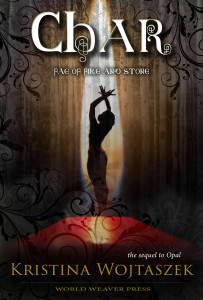
Char lived up to my expectations in almost every way. However, once I finished reading, I realized the love triangle felt over-emphasized. The interactions between Luna and her love interests were enjoyable—I certainly hopped on one of the ships!
However, I wonder if that emphasis on love was necessary in a story driven by urgency.
Why is Char different from the other faerie books out there? It gives you a sensation of freedom. You are living this journey with Luna, feeling her pain, facing the danger. It’s written so your heart feels like it’s dancing on the pages.
Also, the faerie queen is not perfect. She’s got haunts and regrets so powerful, she often seems like a normal girl. We do not like everything she does, but feel enough sympathy not to judge. It was nice to see her off the pedestal, struggling alongside her people.
Luna’s fate at the end was so harsh, it almost made me sick. It showed how human-like these faeries could be, making decisions based on feelings of fear and betrayal. Events in Char were arranged to shock readers, dropping a bomb.
Char has several traits which make it worth the read:
Clever character development. It must take delicate planning to make the faerie queen so vulnerable that readers feel sympathy, despite the darker things she has done.
A setting written like artwork. You smell the forest as it’s described, feel grass under your feet. You aren’t turning the pages of a book—you’re living a story!
The ending. It has a powerful effect, shattering what was generally a peaceful setting. We are pulled along harmoniously, and the ending shatters our daydream.
In all, Char was a beautiful book that’ll have my mind reeling for a long time. It’s a faery tale you can taste and smell. Give this book a try if you like faeries or are a lover of nature; I promise you won’t be disappointed!
Filed under: Book Reviews Tagged: book review, books, faery tale, fantasy, fiction, kristina wojtaszek, reading








May 29, 2016
3 Lessons I Learned Self-Publishing

On June 1 I celebrate my first book birthday; it marks one year since the publication of Dissonance. I am not promoting one method of publishing over another; traditional has great benefits. I am simply recounting my experience taking the ‘least popular’ road.
If you haven’t read Dissonance, new readers make an author’s day; I hope you give it a try!
Years before I had a manuscript ready, there was strong bias against self-publishing. Everyone called it an easy way out, a quitter’s path. An acquaintance went so far as to label it ‘literary suicide.’
She wasn’t the only person I knew with that bitter view; we were fresh on our journeys in the writing life. All of us dreamed of being taken by a literary agency, as if only then could our talent be confirmed. It seemed that no one who took her work seriously planned to self-publish.
Then, people realized times had changed. More people dared take the indie route, but not because it was easier—they all had their motives. As their self-pub journeys proved not to be disasters, the world of indie literature grew.
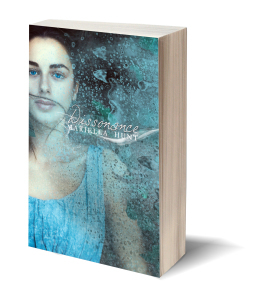
By the time Dissonance was ready to go, self-publishing had become a legitimate option. That isn’t to say my choice was easy: some people were so faithful to their bias against self-pub that I lost friends I considered dear.
Feeling rejected, it wasn’t easy to go on with my plan, but I was ready to be an author. Encouraged by friends and family, and especially my dear mother, I hit Publish and waited to see what would come next.
It was not ‘literary suicide.’ I have learned so much about writing, publishing, and business since releasing Dissonance a year ago. Here are three ways self-publishing helped me to grow and follow my heart.
I BEGAN TO DELIGHT IN FAILURE.
The artist’s journey is one of discovery and pushing boundaries, doing things others haven’t tried, shattering expectations—including your own. I’ve experimented with methods of promotion which fell flat, but at least I tried.
Historically, people have changed the world by carrying out experiments so silly no one else bothered with them. In rare occasions, those projects ended in success. Indie publishing gives me the chance to try things.
I will keep experimenting with methods as an artist and writer, even embracing the failures. What matters is that I try.
TIME IS LIMITED, SO I LEARNED TO PRIORITIZE.
If you want to find gold, take time to dig. Despite what many say, writing is a job. If you don’t take your work seriously, don’t expect to be taken seriously.
No one can write all day, and promotion never sounds exciting. However, indie publishing makes it fun! You get online and make friends, tell them about this story you wrote. Make them part of the process, and every moment you put in is worth it.
It’s important to live offline, too. Just don’t do your story an injustice by asking readers to spend time with your work if you aren’t willing to invest it yourself. Put yourself out there and find a loyal audience!
I LEARNED TO MOVE ON.
Indie publishing has the advantage of letting us make changes whenever we want. All writers know it’s hard to finish a manuscript and say this is it. However, with indie books, there’s not even a limit after hitting Publish.
You have to get the story right, and the edits, and the cover, and the marketing. But make sure you aren’t so caught up that you stop writing altogether. Your second book promotes the first.
Readers want a second book; it will lure more readers to the first. I’m eager to put out my sequel soon. I can’t wait to meet new people, grow as a writer, and have two novels to my name.
This is only my first book birthday, and I still have a long way to go. I have failures to learn from, friends to make, sentences to rearrange. Most of all, I have books to sign, stories to tell, and I’m comfortable knowing I took the first step.
Self-publishing was not literary suicide to me; it was growth. I learned how I could improve and what steps to take next. I realized storytelling is a business so delicate, we have to get extra creative to succeed.
Traditional publishing has benefits, and one day I plan to pursue it. But never let the bias of others influence your decisions. Ironically, many people who judged me for self-publishing stopped writing.
Every path is different. Embrace your freedom, storyteller, to choose the one which suits you.
Filed under: Writing











